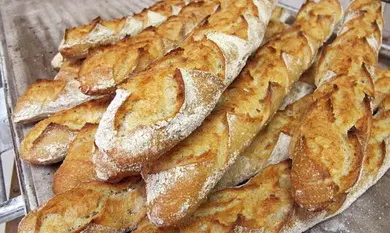This site uses only a few technical cookies necessary for its operation. By continuing to browse, you accept their use.
To find out more...
To find out more...
The French baguette and UNESCO

As you may have already read here or there, France has initiated for some time the procedure to try to have the French baguette classified as an intangible world heritage by UNESCO.
When you put it like that, it sounds a bit namby-pamby, and it would be tempting to imagine an American (for example) sniggering at those Frenchies and their damn baguette that they love so much.
But it's not as simplistic as that, because for us French, the relationship with bread is very particular.
When you put it like that, it sounds a bit namby-pamby, and it would be tempting to imagine an American (for example) sniggering at those Frenchies and their damn baguette that they love so much.
But it's not as simplistic as that, because for us French, the relationship with bread is very particular.
15 K 4.9/5 (22 reviews)
Keywords for this post:BaguetteFranceUnescoWorldHeritageLast modified on: March 18th 2020
The French baguette and UNESCO
First of all, and even if we are used to it, let's not forget that bread is the cornerstone of our diet, even if its consumption has been steadily decreasing for years, it still remains something very important for us, on a daily basis. To be convinced of this, we need only look at the astonishing number of expressions in French that refer to bread: "Manger son pain blanc", "Lui faire passer le gout du pain", "Du pain sur la planche"... etc.
Then our bread, or rather our breads, have an almost unique specificity in the world, it is that they are crispy. We all appreciate a warm bread that comes out of the oven, and that crunches when you cut it or eat it, it doesn't look like much but it's typically French. It's a delight of texture, but also of taste because 80% of the taste of the bread is in the crust. And if you have travelled outside of France, you will have noticed, especially in Anglo-Saxon countries, the poor quality of breads, let's say "crumb bread", under plastic, their frightening composition, and their almost total absence of taste, associated with their suspicious elasticity after 3 weeks in the cupboard.
The baguette is even more French, almost Parisian it must be admitted, this long and thin bread, golden and crispy, with a very short shelf life (6h max) that we buy every day, or even several times a day, we are the only ones in the world to do that, and we do it a lot: 32 million baguettes are sold in France every day. So there is no need to specify "French baguette", because a baguette is only French.
It is however very simple as a recipe: water + flour + salt + leaven + a drop of yeast, but all the talent of the baker comes afterwards: long fermentation, short kneading, quality of the products, careful cooking, to finally obtain an exceptional product.
I had already mentioned in a previous post that there was baguette and baguette, and that it was necessary at all costs (yes, well, I'm exaggerating a bit, but it's a subject that touches me a lot) to prefer the "traditional" baguette, if possible well baked, because it's so much better for the taste and also for the health.
All this to tell you, that no, this classification request is not a baker's whim, we are indeed with the baguette on a real French specificity, which deserves to be distinguished.
And then, oh, the Neapolitans have already obtained it for the pizza ;-)...
To sum up: The French baguette classified as a UNESCO world heritage site? But of course, what a fair recognition of a so french product !
Then our bread, or rather our breads, have an almost unique specificity in the world, it is that they are crispy. We all appreciate a warm bread that comes out of the oven, and that crunches when you cut it or eat it, it doesn't look like much but it's typically French. It's a delight of texture, but also of taste because 80% of the taste of the bread is in the crust. And if you have travelled outside of France, you will have noticed, especially in Anglo-Saxon countries, the poor quality of breads, let's say "crumb bread", under plastic, their frightening composition, and their almost total absence of taste, associated with their suspicious elasticity after 3 weeks in the cupboard.

The baguette is even more French, almost Parisian it must be admitted, this long and thin bread, golden and crispy, with a very short shelf life (6h max) that we buy every day, or even several times a day, we are the only ones in the world to do that, and we do it a lot: 32 million baguettes are sold in France every day. So there is no need to specify "French baguette", because a baguette is only French.
It is however very simple as a recipe: water + flour + salt + leaven + a drop of yeast, but all the talent of the baker comes afterwards: long fermentation, short kneading, quality of the products, careful cooking, to finally obtain an exceptional product.

I had already mentioned in a previous post that there was baguette and baguette, and that it was necessary at all costs (yes, well, I'm exaggerating a bit, but it's a subject that touches me a lot) to prefer the "traditional" baguette, if possible well baked, because it's so much better for the taste and also for the health.
All this to tell you, that no, this classification request is not a baker's whim, we are indeed with the baguette on a real French specificity, which deserves to be distinguished.
And then, oh, the Neapolitans have already obtained it for the pizza ;-)...
To sum up: The French baguette classified as a UNESCO world heritage site? But of course, what a fair recognition of a so french product !
Lasts posts
Butter vs. grease
We often read in a recipe where a pastry is put into a mould that, just before pouring, the mould should be buttered or greased. But what's the difference between these 2 terms?December 1st 20259655
Getting out of the fridge early
Very often when you're cooking, you need to take food or preparations out of the fridge, to use them in the recipe in progress. There's nothing tricky about this: you just take them out of the fridge and use them, usually immediately, in the recipe. But is this really a good method?November 24th 20251,0915
Who's making the croissants?
When you look at a bakery from the outside, you naturally think that in the bakery, the bakers make the bread, and in the laboratory, the pastry chefs make the cakes. It's very often like that, with each of these professions having quite different ways of working, but sometimes there's also one...November 23th 2025988
Oven height
When we put a dish or cake in the oven, we naturally tend to put it on the middle shelf, and that's what we usually do. But in some cases, this position and height can be a little tricky, so let's find out why.October 8th 20252,7065
The importance of sieving
In recipes that use a fine powder (flour, powdered sugar, etc.), you'll often see the advice to sift before using it. To sift is to pass the powder in question through a sieve (a very fine strainer) before incorporating it into your recipe. It's often advice, but is it really useful?September 3rd 20257,5173
Other pages you may also like
Clean your mixer easily
If you use a "bowl" or "blender" mixer, as opposed to a plunger, you've probably noticed that it's a bit of a hassle to clean it after use. And yet, with a simple trick, it can be done very quickly. See how here.June 26th 20248,1285
How to sprinkle well?
When in a recipe you need to sprinkle something, that is to say to spread a fine layer of powder (flour, sugar, etc.) on something, powdered sugar on a pie for example, you will probably use a fine strainer or a sieve, this is the best way to proceed. But is that all?May 23th 202310 K4.7
Maillard reactions
This subject cropped up recently in a discussion with my three charming nieces; do you know what Maillard reactions are? With a name like that, they could well be some principle in mechanics, but in fact the term applies to something much closer to all of us: it's what gives food more flavour...January 28th 201538 K4
Butter doesn't make you fat, unless you eat too much of it.
Whenever I'm discussing cooking and recipes, there is one idea which comes up frequently, like this: "Oh no! But that's got butter in it" (I should add, for the sake of accuracy, that this is something I hear more frequently from women, who are almost all concerned with keeping their figure). ...March 26th 201245 K4.5
Beans in primeur
As I write this, it is the beginning of the short season for fresh beans. If you've never made them before and you're just starting out (and that's a great idea) you'll find that it's a bit time consuming to prepare, you have to shell them once, remove the beans, scald them to remove the skin (and...June 4th 202214 K
Post a comment or question
Follow this page
If you are interested in this page, you can "follow" it, by entering your email address here. You will then receive a notification immediately each time the page is modified or a new comment is added. Please note that you will need to confirm this following.
Note: We'll never share your e-mail address with anyone else.
Alternatively: you can subscribe to the mailing list of cooling-ez.com , you will receive a e-mail for each new recipe published on the site.









